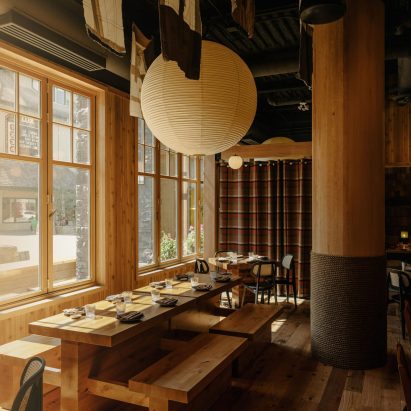Welcome to the fascinating world of Japanese restaurant decor! As someone who has dined in numerous Japanese restaurants and even tried my hand at creating a Japanese-inspired ambiance at home, I understand how essential the decor is in enhancing the dining experience. Not only does it set the mood, but it also pays homage to a rich cultural heritage. In this article, we will explore various aspects of Japanese restaurant decor, its significance, and, for those puzzle enthusiasts out there, we’ll dive into the crossword clues related to this theme!
Understanding Japanese Restaurant Decor
Japanese decor is a beautiful blend of aesthetics, culture, and functionality. Whether you’re designing a restaurant or simply looking to spice up your home, understanding the elements that make up traditional Japanese decor is crucial.
Key Elements of Japanese Restaurant Decor
- Natural Materials: Wood, bamboo, stone, and paper are commonly used.
- Minimalism: Less is more! The decor typically emphasizes simplicity and elegance.
- Nature-Inspired Designs: Incorporating elements of nature like bonsai trees or water features.
- Traditional Art: Ukiyo-e (woodblock prints) and calligraphy often grace the walls.
- Lighting: Soft, warm lighting creates a calm, inviting atmosphere.
Why is Decor Important in Japanese Restaurants?
The decor in a Japanese restaurant does more than just beautify the space; it creates an immersive experience for diners. The ambiance can evoke feelings of tranquility and appreciation for the meal, aligning with the Japanese philosophy of omotenashi, which emphasizes hospitality.
Common Features Found in Japanese Restaurant Decor
Let’s delve deeper into the specific features that you might encounter in a Japanese restaurant.

1. Tatami Mats
Tatami mats are traditional Japanese flooring made from rice straw and covered with a woven rush grass. They add a unique cultural element to the restaurant while providing comfort.
2. Shoji Screens
Shoji screens are sliding doors made from translucent rice paper and wooden frames. They serve as room dividers while allowing light to filter through, creating a serene environment.

3. Engaging Decor Items
Items such as kokeshi dolls, sake sets, and traditional pottery not only serve decorative purposes but also showcase Japanese craftsmanship.
4. Zen Gardens
Some restaurants incorporate mini Zen gardens to promote calmness and mindfulness. These features can serve as a delightful focal point.

Personal Experience with Japanese Decor
During my visit to a traditional izakaya in Kyoto, I was struck by how the decor complemented the food. The wooden beams and paper lanterns created an intimate yet lively atmosphere. The attention to detail—from the arrangement of the sake bottles to the calligraphy on the wall—made the experience memorable. It was a perfect fusion of culinary art and aesthetic beauty.
Decoding the Crossword Clue: Japanese Restaurant Decor
For crossword enthusiasts, you might have stumbled upon clues related to Japanese decor. Let’s explore some common clues and their potential answers.

Common Crossword Clues
| Clue | Answer | Length |
|---|---|---|
| Japanese paper screen | Shoji | 5 |
| Japanese flooring mats | Tatami | 6 |
| Decorative Japanese doll | Kokeshi | 6 |
| Zen garden material | Sand | 4 |
| Rice paper | Washi | 5 |
Tips for Solving Crossword Clues
Here are some tips to help you successfully navigate crossword puzzles related to Japanese decor:
- Familiarize yourself with common Japanese terms and materials.
- Think about the cultural significance of various decor items.
- Consider the context of the clue; it may point to a style or a specific item.

Pros and Cons of Implementing Japanese Decor
Like any design style, Japanese decor comes with its unique advantages and challenges. Let us take a closer look.
Pros
- Cultural Richness: Brings a sense of culture and tradition into modern settings.
- Tranquility: Creates a calm and serene environment for diners.
- Visual Appeal: The aesthetic elements are visually captivating and memorable.
- Brand Identity: Helps establish a unique identity for the restaurant.

Cons
- Cost: Authentic materials can be expensive.
- Space Requirements: Some elements, like tatami mats and shoji screens, require a dedicated space.
- Maintenance: Natural materials can require regular maintenance to keep them looking fresh.
Incorporating Japanese Decor at Home
If you’re inspired by this decor style and want to bring it into your home, here are some tips to consider:
1. Start Small
Incorporate elements like a couple of shoji screens or a small Zen garden to ease into the aesthetic.
2. Focus on Authenticity
Choose authentic items that reflect Japanese craftsmanship. Look for handmade pottery or wooden decor.
3. Balance is Key
Ensure that your decor is balanced and not overly cluttered. Remember, minimalism is a hallmark of Japanese design.
4. Create a Tranquil Space
Use natural light where possible and opt for soft, warm lighting to create a calming atmosphere.
FAQs About Japanese Restaurant Decor
What is the significance of Japanese decor in restaurants?
Japanese decor is significant because it creates a dining atmosphere that reflects cultural heritage, hospitality, and mindful eating.
What materials are commonly used in Japanese decor?
Common materials include wood, bamboo, rice paper, and stone, which contribute to a natural and serene environment.
How can I achieve Japanese-style decor at home?
You can achieve Japanese-style decor by incorporating items like tatami mats, shoji screens, and natural materials, while focusing on minimalism and tranquility.
Are there specific colors associated with Japanese decor?
Yes, traditional Japanese decor often utilizes earth tones, whites, and muted colors to promote a serene and harmonious environment.
Conclusion
Exploring Japanese restaurant decor opens up a world of cultural appreciation and immersive dining experiences. Whether you’re solving crossword puzzles or redesigning your space, understanding the elements and significance of this decor will elevate your appreciation of Japanese culture. The next time you dine at a Japanese restaurant, take a moment to enjoy the decor, as it plays an essential role in your overall dining experience.
Have you ever dined in a Japanese restaurant that left a lasting impression on you? Share your experiences below!